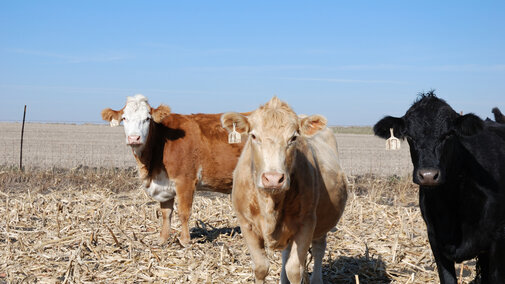Grazing Value of Grain Sorghum Stover
There are sizable acres of sorghum residue available for grazing this year and, similar to corn, sorghum stover can be a valuable winter forage. How does sorghum stover compare to corn residue for winter grazing?
Both corn residue and sorghum stover can sustain mid- to late-gestation cattle without supplementation during early grazing. Sorghum leaves have similar quality to corn husks and leaves. And just like corn residue, the quality decreases over time.
Stocking rates for grazed sorghum stover are calculated using grain yield. For example, stocking rates for sorghum stover that produced 100 bushels of grain per acre will support grazing at one acre for one cow for one month. However, different herbicides are used for sorghum than corn, so it is important to check the labels to be sure they are labeled for grazing.
Unlike corn residue, sorghum stover has a threat of prussic acid toxicity immediately following a frost since sorghum plants are often still green at harvest. In fact, it carries the greatest risk of all sorghum species. Following a frost, it is important to wait seven days after a killing freeze to make sure the possibility of prussic acid toxicity is reduced. The possibility of nitrate toxicity exists, especially if cattle are forced to graze the lower part of the stems.
Sorghum stover has a several positive characteristics compared to corn residue. Sorghum stems are a little higher in quality than the corn stem, but care is still needed if cows are forced to graze the lower stems. Sorghum stover is not on the ground like corn residue, so there is less loss to trampling and fewer issues with mud, if we have a wet fall. Sorghum stover also tends to remain above any snow that falls during winter.
Finally, spilled sorghum grain is a little safer than corn and not as likely to cause acidosis or founder as corn grain.
Getting the Most from Grazing Corn Residue
Corn harvest is starting. That means corn residue will soon be available for grazing. How should grazing be managed to get the most out of them?
When corn residue becomes available for grazing, several decisions need to be made. For starters, how soon should you move cows to graze the residue? Most years you probably should start grazing as soon as possible. The nutrient value of residue declines the longer it is exposed to weathering. Grazing residue right away will put more condition on cows and faster gains on stockers.
But be sure to check fields for excess grain before grazing. Fields with small ears or fields with wind damage may have more grain loss than usual. Too much corn can cause acidosis and founder. Adapt cattle to a higher grain ration before grazing if a problem is expected.
How to graze is another decision. Be careful, though, about forcing cows to eat the lower stalks. They won’t get much protein or energy from lower stalks and nitrate levels might be dangerously high. If heavy snow or mud occurs before you graze all areas, some good quality feed can be lost.
Whole-field grazing permits fast, early gains but more supplements are needed late in the season after all grain has disappeared. Strip grazing by giving animals only one or two weeks-worth of grazing at a time uses the residue more efficiently than leaving cattle in the same entire field for a couple months or longer. Strip grazing permits a higher stocking rate and provides a more uniform diet.
Whatever your grazing strategy, consider carefully what kind of nutrition animals are getting from the residue, so you neither underfeed nor overfeed expensive supplements.
Be sure to provide salt, calcium, phosphorus and vitamin A free choice at all times. And once all the grain is gone, cows will need about half a pound per day of an all-natural protein to meet nutrient needs.
Corn residue grazing season is here. Make wise decisions to use it in best way possible.

